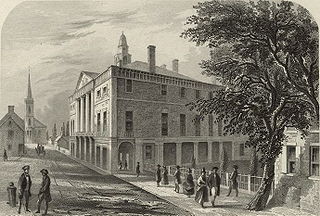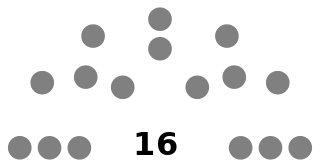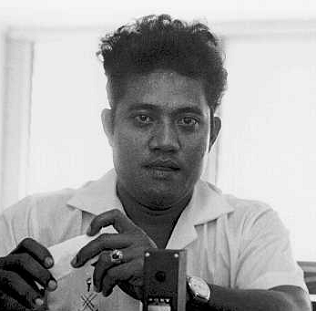Related Research Articles

Politics of the Northern Mariana Islands takes place in a framework of a presidential representative democratic system, whereby the Governor is head of government, and of a pluriform multi-party system. The Northern Mariana Islands is an unincorporated territory of the United States, and in a political union with it in the form of a commonwealth. Executive power is exercised by the governor. Legislative power is vested in the two chambers of the legislature. The judiciary is independent of the executive and the legislature. Local government is carried out through three regional mayors.

Since Hawaii became a state in 1959, it has sent congressional delegations to the United States Senate and United States House of Representatives. Each state elects two senators to serve for six years. Members of the House of Representatives are elected to two-year terms, one from each of Hawaii's congressional districts. Before becoming a state, the Territory of Hawaii elected a non-voting delegate at-large to Congress from 1900 to 1958.

The 1st United States Congress, comprising the United States Senate and the United States House of Representatives, met from March 4, 1789, to March 4, 1791, during the first two years of George Washington's presidency, first at Federal Hall in New York City and later at Congress Hall in Philadelphia. With the initial meeting of the First Congress, the United States federal government officially began operations under the new frame of government established by the 1787 Constitution. The apportionment of seats in the House of Representatives was based on the provisions of Article I, Section 2, Clause 3 of the Constitution. Both chambers had a Pro-Administration majority. Twelve articles of amendment to the Constitution were passed by this Congress and sent to the states for ratification; the ten ratified as additions to the Constitution on December 15, 1791, are collectively known as the Bill of Rights, with an additional amendment ratified more than two centuries later to become the Twenty-seventh Amendment to the United States Constitution.

Since Utah became a U.S. state in 1896, it has sent congressional delegations to the United States Senate and United States House of Representatives. Each state elects two senators to serve for six years. Before the Seventeenth Amendment in 1913, senators were elected by the Utah State Legislature. Members of the House of Representatives are elected to two-year terms, one from each of Utah's four congressional districts. Before becoming a state, the Territory of Utah elected a non-voting delegate at-large to Congress from 1850 to 1896.

These are tables of congressional delegations from Indiana to the United States House of Representatives and the United States Senate.
The 1860–61 United States House of Representatives elections were held on various dates in various states between August 6, 1860 and October 24, 1861, before or after the first session of the 37th United States Congress convened on July 4, 1861. The number of House seats initially increased to 239 when California was apportioned an extra one, but these elections were affected by the outbreak of the American Civil War and resulted in over 56 vacancies.

The 1812–13 United States House of Representatives elections were held on various dates in various states between August 3, 1812 and April 30, 1813. Each state set its own date for its elections to the House of Representatives before the first session of the 13th United States Congress convened on May 24, 1813. They coincided with James Madison being re-elected president.

The Northern Mariana Islands Commonwealth Legislature is the territorial legislature of the U.S. commonwealth of the Northern Mariana Islands. The legislative branch of the territory is bicameral, consisting of a 20-member lower House of Representatives, and an upper house Senate with nine senators. Representatives serve two-year terms and senators serve four-year terms, both without term limits. The territorial legislature meets in the commonwealth capital of Saipan.

The House of Delegates of Palau is the lower house of the Palau National Congress, Palau's bicameral legislature. The Senate of Palau is the upper house. The House of Delegates has 16 members, each serving four-year terms in single-seat constituencies. Each state represents one constituency. No political parties exist. The last election was held on 3 November 2020.

The United States House of Representatives is the lower chamber of the United States Congress, with the Senate being the upper chamber. Together, they comprise the national bicameral legislature of the United States.

The 2024 United States elections are scheduled to be held, in large part, on Tuesday, November 5, 2024. During this presidential election year, the President of the United States and Vice President will be elected. In addition, all 435 seats in the United States House of Representatives and 34 of the 100 seats in the United States Senate will be contested to determine the membership of the 119th United States Congress. Thirteen state and territorial governorships and numerous other state and local elections will also be contested.

The Congress of Micronesia was a bicameral legislature in Trust Territory of the Pacific Islands from 1964 to 1979.
Parliamentary elections were held in the Trust Territory of the Pacific Islands on 19 January 1965.
Parliamentary elections were held in the Trust Territory of the Pacific Islands on 8 November 1966.
Parliamentary elections were held in the Trust Territory of the Pacific Islands on 3 November 1970.
Parliamentary elections were held in the Trust Territory of the Pacific Islands on 5 November 1968, except in the Marshall Islands, where they were delayed until 20 December due to an outbreak of flu.

Francis Nuuan was a Micronesian educator and politician. He served as a member of the Senate of the Trust Territory of the Pacific Islands between 1965 and 1969.
Parliamentary elections were held in the Trust Territory of the Pacific Islands on 5 November 1974. Carmen Bigler became the first female member of Congress after being elected to House of Representatives from the Fifth District of the Marshall Islands.
Parliamentary elections were held in the Trust Territory of the Pacific Islands on 2 November 1976, except in Palau, where they were delayed until 7 December due to a legal challenge over redistricting. They were the last territory-wide elections; the planned elections in 1978 were cancelled as the territory was split into the Federated States of Micronesia, the Marshall Islands and Palau.

Ambilos Iehsi was a Micronesian politician. He served as a member of the House of Representatives and Senate of the Congress of the Trust Territory of the Pacific Islands between 1967 until 1979, and then as Secretary of Resources and Development of the Federated States of Micronesia.
References
- ↑ Congress Election Results Reported Highlights, 15 November 1972, p1
- ↑ Report to the United Nations on the Administration of the Trust Territory of the Pacific Islands, Transmitted by the United States of America United States Department of State, pp173–174
- ↑ Congress Opens Session on Saipan Highlights, 15 January 1973, p3